Business Law Report: Decorator Agencies Pty Ltd v Jeffries
VerifiedAdded on 2020/03/23
|12
|2750
|178
Report
AI Summary
This report provides an analysis of the Australian case Decorator Agencies Pty Ltd v Jeffries Industries Ltd (1998), focusing on the breach of duties by the chairman of Jeffries. The report details the case's background, including the company's share structure and the chairman's actions to manipulate share prices. It examines the breached responsibilities under the Corporations Act, the court's decision, and its implications for Australian corporations law. The chairman's actions, motivated by personal gain, involved selling shares to decrease the allotment, leading to legal repercussions. The report discusses the relevance of the decision to the development of Australian corporations law and its impact on the operation of companies in Australia. The case highlights issues of market manipulation and the importance of adhering to corporate governance.
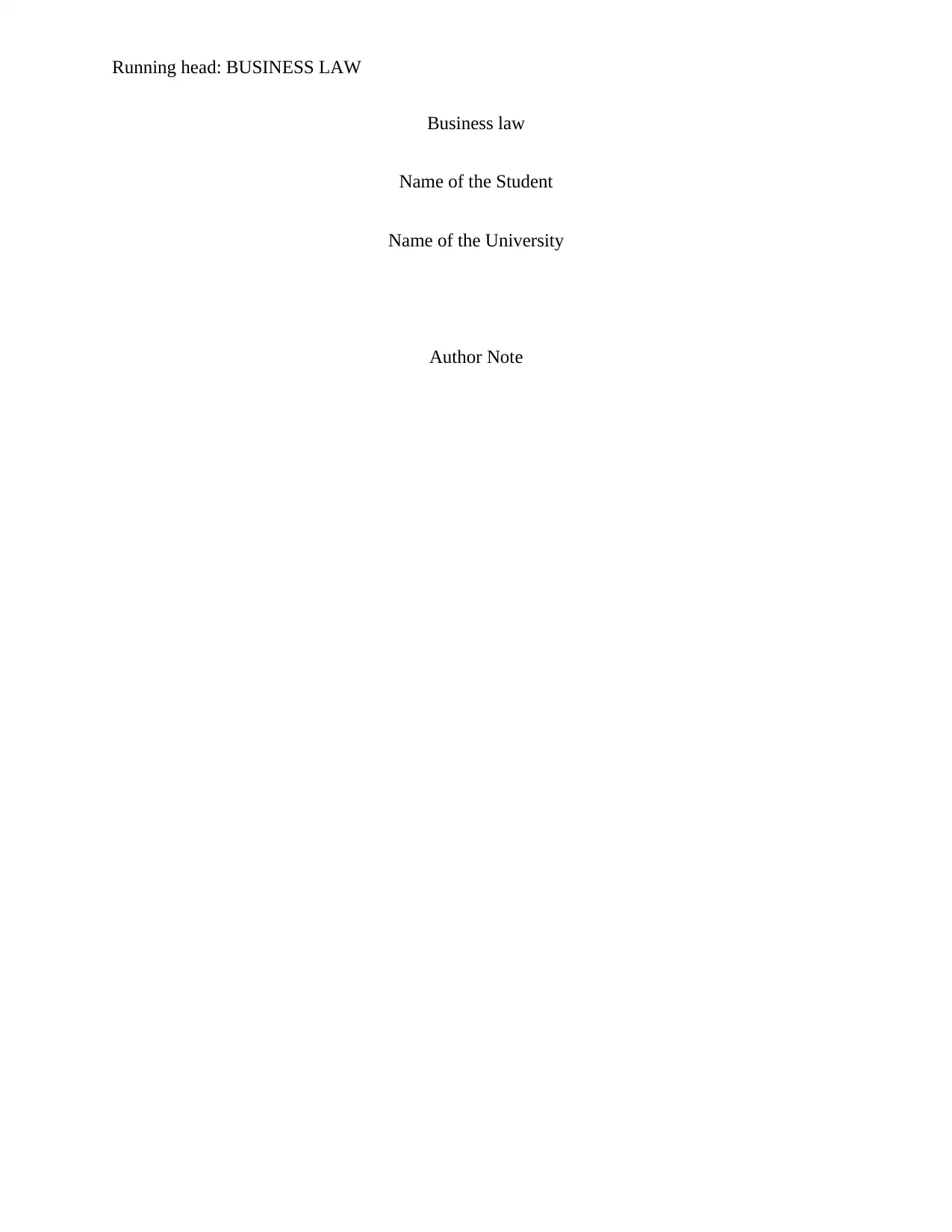
Running head: BUSINESS LAW
Business law
Name of the Student
Name of the University
Author Note
Business law
Name of the Student
Name of the University
Author Note
Paraphrase This Document
Need a fresh take? Get an instant paraphrase of this document with our AI Paraphraser
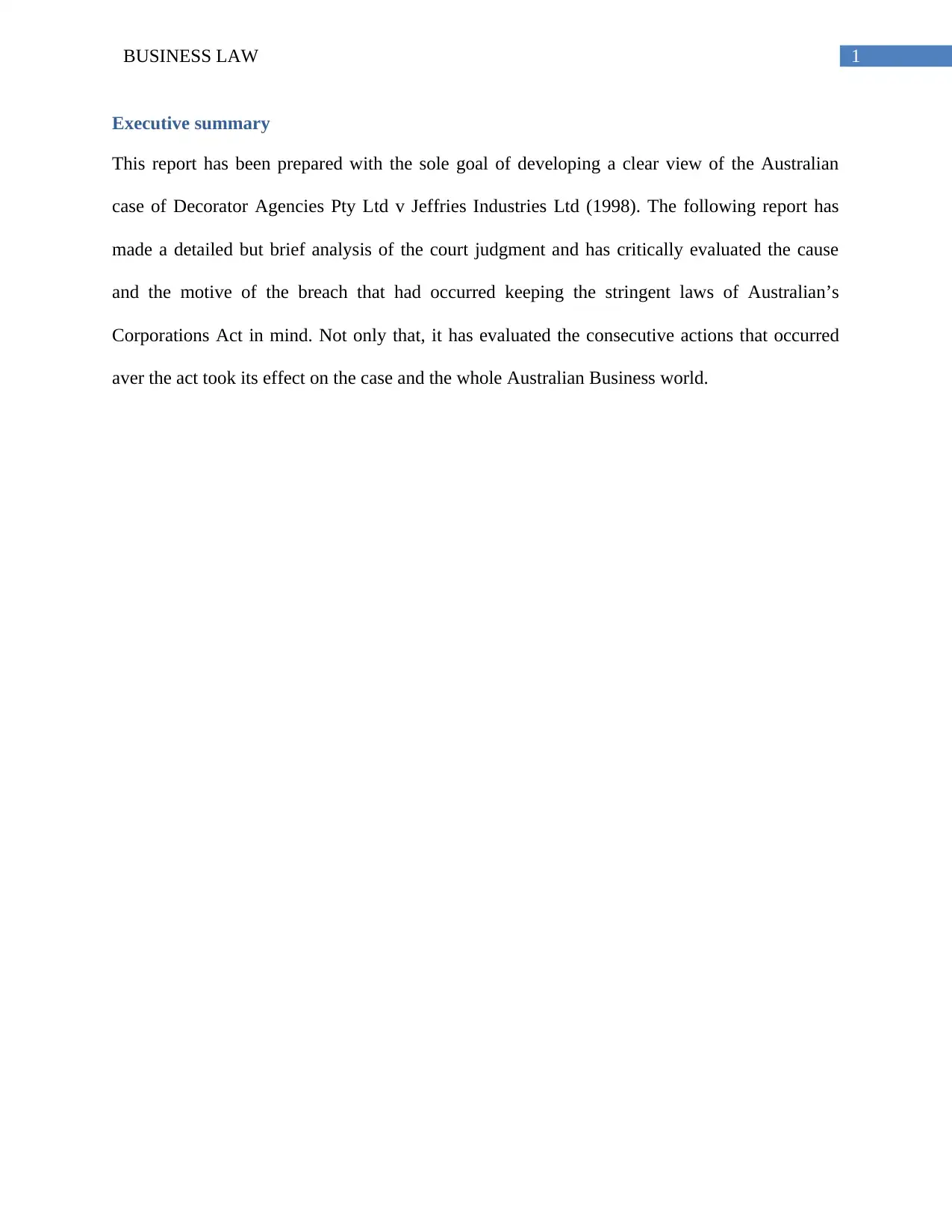
1BUSINESS LAW
Executive summary
This report has been prepared with the sole goal of developing a clear view of the Australian
case of Decorator Agencies Pty Ltd v Jeffries Industries Ltd (1998). The following report has
made a detailed but brief analysis of the court judgment and has critically evaluated the cause
and the motive of the breach that had occurred keeping the stringent laws of Australian’s
Corporations Act in mind. Not only that, it has evaluated the consecutive actions that occurred
aver the act took its effect on the case and the whole Australian Business world.
Executive summary
This report has been prepared with the sole goal of developing a clear view of the Australian
case of Decorator Agencies Pty Ltd v Jeffries Industries Ltd (1998). The following report has
made a detailed but brief analysis of the court judgment and has critically evaluated the cause
and the motive of the breach that had occurred keeping the stringent laws of Australian’s
Corporations Act in mind. Not only that, it has evaluated the consecutive actions that occurred
aver the act took its effect on the case and the whole Australian Business world.

2BUSINESS LAW
Table of Contents
Case Introduction.............................................................................................................................3
The duties/responsibilities breached (ex. CA sections 181 or 588G) and explain why the duties
were breached..................................................................................................................................4
Discuss and critically ANALYSE the court/tribunal decision and the reason for the decision in
view of the Corporations Act...........................................................................................................5
Where possible and applicable, the relevance of the decision to the development of Australian
corporations law or the impact of the decision on the operation of companies in Australia...........6
Conclusion:......................................................................................................................................7
References:....................................................................................................................................10
Table of Contents
Case Introduction.............................................................................................................................3
The duties/responsibilities breached (ex. CA sections 181 or 588G) and explain why the duties
were breached..................................................................................................................................4
Discuss and critically ANALYSE the court/tribunal decision and the reason for the decision in
view of the Corporations Act...........................................................................................................5
Where possible and applicable, the relevance of the decision to the development of Australian
corporations law or the impact of the decision on the operation of companies in Australia...........6
Conclusion:......................................................................................................................................7
References:....................................................................................................................................10
⊘ This is a preview!⊘
Do you want full access?
Subscribe today to unlock all pages.

Trusted by 1+ million students worldwide
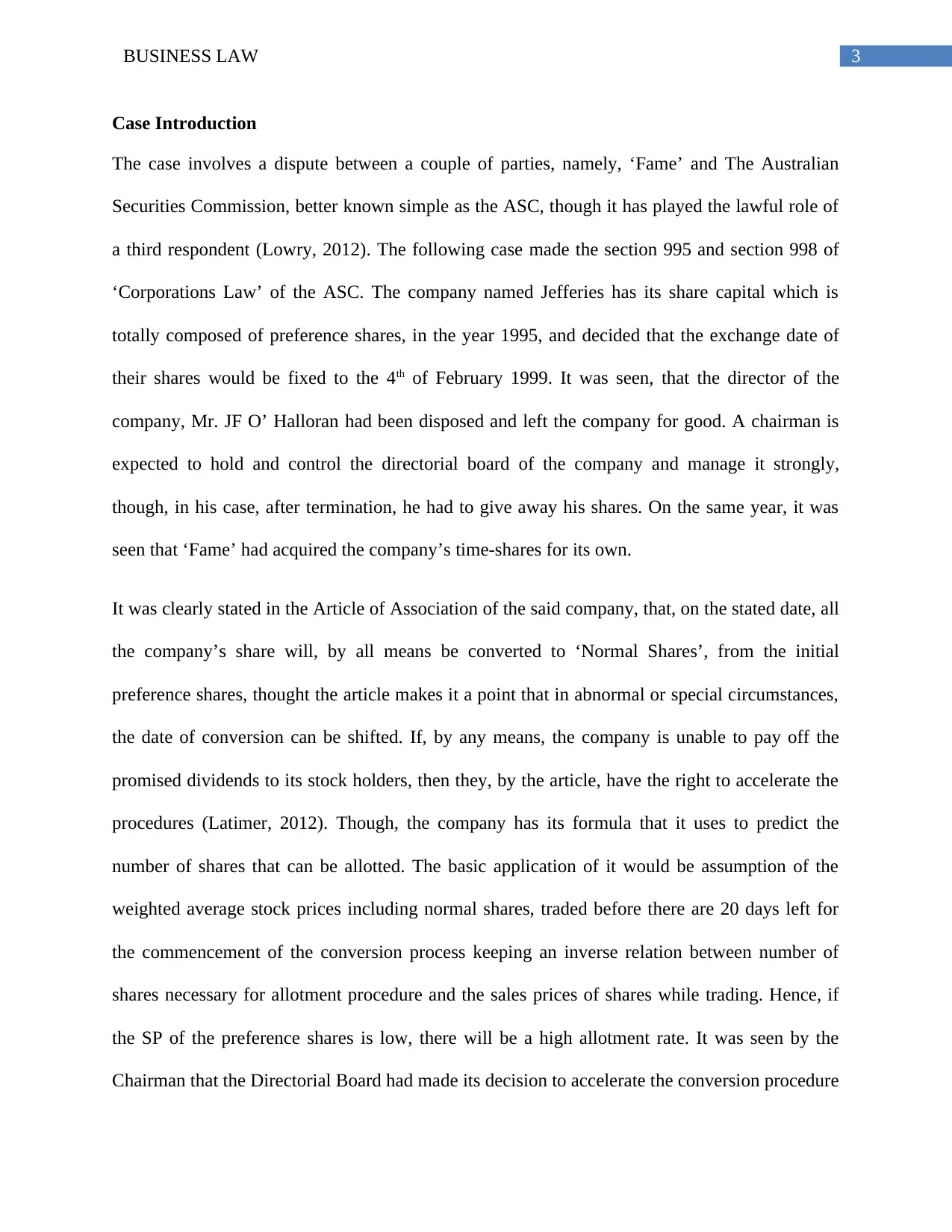
3BUSINESS LAW
Case Introduction
The case involves a dispute between a couple of parties, namely, ‘Fame’ and The Australian
Securities Commission, better known simple as the ASC, though it has played the lawful role of
a third respondent (Lowry, 2012). The following case made the section 995 and section 998 of
‘Corporations Law’ of the ASC. The company named Jefferies has its share capital which is
totally composed of preference shares, in the year 1995, and decided that the exchange date of
their shares would be fixed to the 4th of February 1999. It was seen, that the director of the
company, Mr. JF O’ Halloran had been disposed and left the company for good. A chairman is
expected to hold and control the directorial board of the company and manage it strongly,
though, in his case, after termination, he had to give away his shares. On the same year, it was
seen that ‘Fame’ had acquired the company’s time-shares for its own.
It was clearly stated in the Article of Association of the said company, that, on the stated date, all
the company’s share will, by all means be converted to ‘Normal Shares’, from the initial
preference shares, thought the article makes it a point that in abnormal or special circumstances,
the date of conversion can be shifted. If, by any means, the company is unable to pay off the
promised dividends to its stock holders, then they, by the article, have the right to accelerate the
procedures (Latimer, 2012). Though, the company has its formula that it uses to predict the
number of shares that can be allotted. The basic application of it would be assumption of the
weighted average stock prices including normal shares, traded before there are 20 days left for
the commencement of the conversion process keeping an inverse relation between number of
shares necessary for allotment procedure and the sales prices of shares while trading. Hence, if
the SP of the preference shares is low, there will be a high allotment rate. It was seen by the
Chairman that the Directorial Board had made its decision to accelerate the conversion procedure
Case Introduction
The case involves a dispute between a couple of parties, namely, ‘Fame’ and The Australian
Securities Commission, better known simple as the ASC, though it has played the lawful role of
a third respondent (Lowry, 2012). The following case made the section 995 and section 998 of
‘Corporations Law’ of the ASC. The company named Jefferies has its share capital which is
totally composed of preference shares, in the year 1995, and decided that the exchange date of
their shares would be fixed to the 4th of February 1999. It was seen, that the director of the
company, Mr. JF O’ Halloran had been disposed and left the company for good. A chairman is
expected to hold and control the directorial board of the company and manage it strongly,
though, in his case, after termination, he had to give away his shares. On the same year, it was
seen that ‘Fame’ had acquired the company’s time-shares for its own.
It was clearly stated in the Article of Association of the said company, that, on the stated date, all
the company’s share will, by all means be converted to ‘Normal Shares’, from the initial
preference shares, thought the article makes it a point that in abnormal or special circumstances,
the date of conversion can be shifted. If, by any means, the company is unable to pay off the
promised dividends to its stock holders, then they, by the article, have the right to accelerate the
procedures (Latimer, 2012). Though, the company has its formula that it uses to predict the
number of shares that can be allotted. The basic application of it would be assumption of the
weighted average stock prices including normal shares, traded before there are 20 days left for
the commencement of the conversion process keeping an inverse relation between number of
shares necessary for allotment procedure and the sales prices of shares while trading. Hence, if
the SP of the preference shares is low, there will be a high allotment rate. It was seen by the
Chairman that the Directorial Board had made its decision to accelerate the conversion procedure
Paraphrase This Document
Need a fresh take? Get an instant paraphrase of this document with our AI Paraphraser
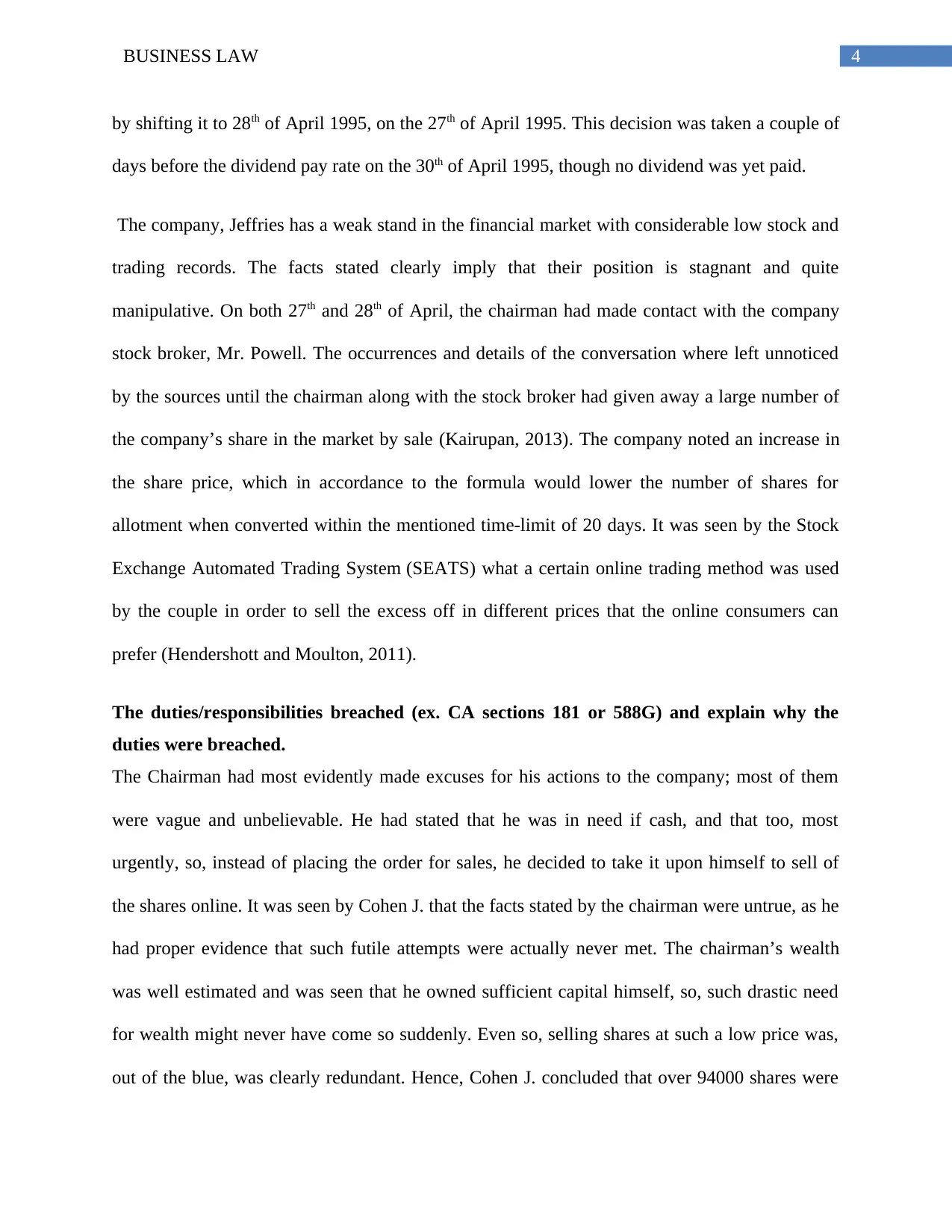
4BUSINESS LAW
by shifting it to 28th of April 1995, on the 27th of April 1995. This decision was taken a couple of
days before the dividend pay rate on the 30th of April 1995, though no dividend was yet paid.
The company, Jeffries has a weak stand in the financial market with considerable low stock and
trading records. The facts stated clearly imply that their position is stagnant and quite
manipulative. On both 27th and 28th of April, the chairman had made contact with the company
stock broker, Mr. Powell. The occurrences and details of the conversation where left unnoticed
by the sources until the chairman along with the stock broker had given away a large number of
the company’s share in the market by sale (Kairupan, 2013). The company noted an increase in
the share price, which in accordance to the formula would lower the number of shares for
allotment when converted within the mentioned time-limit of 20 days. It was seen by the Stock
Exchange Automated Trading System (SEATS) what a certain online trading method was used
by the couple in order to sell the excess off in different prices that the online consumers can
prefer (Hendershott and Moulton, 2011).
The duties/responsibilities breached (ex. CA sections 181 or 588G) and explain why the
duties were breached.
The Chairman had most evidently made excuses for his actions to the company; most of them
were vague and unbelievable. He had stated that he was in need if cash, and that too, most
urgently, so, instead of placing the order for sales, he decided to take it upon himself to sell of
the shares online. It was seen by Cohen J. that the facts stated by the chairman were untrue, as he
had proper evidence that such futile attempts were actually never met. The chairman’s wealth
was well estimated and was seen that he owned sufficient capital himself, so, such drastic need
for wealth might never have come so suddenly. Even so, selling shares at such a low price was,
out of the blue, was clearly redundant. Hence, Cohen J. concluded that over 94000 shares were
by shifting it to 28th of April 1995, on the 27th of April 1995. This decision was taken a couple of
days before the dividend pay rate on the 30th of April 1995, though no dividend was yet paid.
The company, Jeffries has a weak stand in the financial market with considerable low stock and
trading records. The facts stated clearly imply that their position is stagnant and quite
manipulative. On both 27th and 28th of April, the chairman had made contact with the company
stock broker, Mr. Powell. The occurrences and details of the conversation where left unnoticed
by the sources until the chairman along with the stock broker had given away a large number of
the company’s share in the market by sale (Kairupan, 2013). The company noted an increase in
the share price, which in accordance to the formula would lower the number of shares for
allotment when converted within the mentioned time-limit of 20 days. It was seen by the Stock
Exchange Automated Trading System (SEATS) what a certain online trading method was used
by the couple in order to sell the excess off in different prices that the online consumers can
prefer (Hendershott and Moulton, 2011).
The duties/responsibilities breached (ex. CA sections 181 or 588G) and explain why the
duties were breached.
The Chairman had most evidently made excuses for his actions to the company; most of them
were vague and unbelievable. He had stated that he was in need if cash, and that too, most
urgently, so, instead of placing the order for sales, he decided to take it upon himself to sell of
the shares online. It was seen by Cohen J. that the facts stated by the chairman were untrue, as he
had proper evidence that such futile attempts were actually never met. The chairman’s wealth
was well estimated and was seen that he owned sufficient capital himself, so, such drastic need
for wealth might never have come so suddenly. Even so, selling shares at such a low price was,
out of the blue, was clearly redundant. Hence, Cohen J. concluded that over 94000 shares were
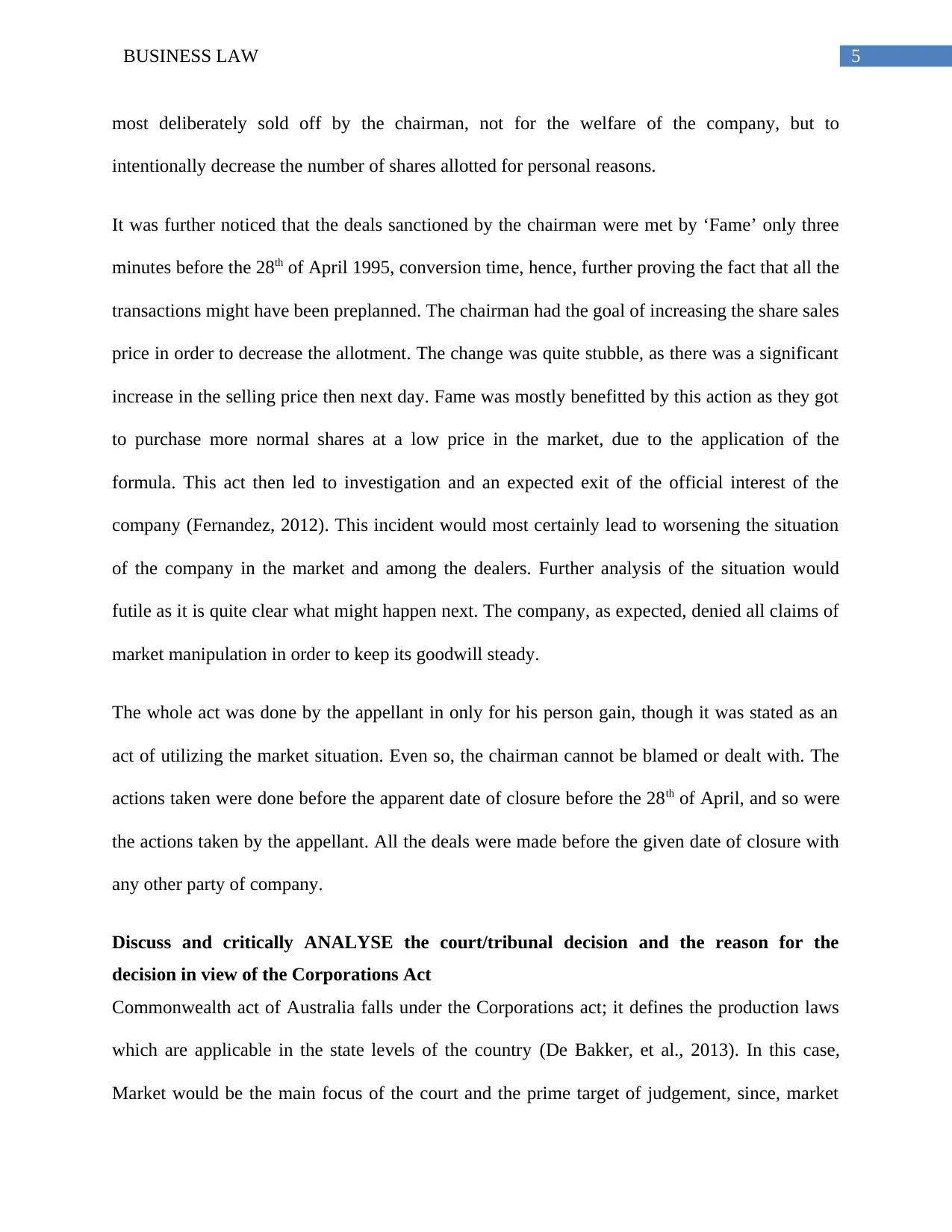
5BUSINESS LAW
most deliberately sold off by the chairman, not for the welfare of the company, but to
intentionally decrease the number of shares allotted for personal reasons.
It was further noticed that the deals sanctioned by the chairman were met by ‘Fame’ only three
minutes before the 28th of April 1995, conversion time, hence, further proving the fact that all the
transactions might have been preplanned. The chairman had the goal of increasing the share sales
price in order to decrease the allotment. The change was quite stubble, as there was a significant
increase in the selling price then next day. Fame was mostly benefitted by this action as they got
to purchase more normal shares at a low price in the market, due to the application of the
formula. This act then led to investigation and an expected exit of the official interest of the
company (Fernandez, 2012). This incident would most certainly lead to worsening the situation
of the company in the market and among the dealers. Further analysis of the situation would
futile as it is quite clear what might happen next. The company, as expected, denied all claims of
market manipulation in order to keep its goodwill steady.
The whole act was done by the appellant in only for his person gain, though it was stated as an
act of utilizing the market situation. Even so, the chairman cannot be blamed or dealt with. The
actions taken were done before the apparent date of closure before the 28th of April, and so were
the actions taken by the appellant. All the deals were made before the given date of closure with
any other party of company.
Discuss and critically ANALYSE the court/tribunal decision and the reason for the
decision in view of the Corporations Act
Commonwealth act of Australia falls under the Corporations act; it defines the production laws
which are applicable in the state levels of the country (De Bakker, et al., 2013). In this case,
Market would be the main focus of the court and the prime target of judgement, since, market
most deliberately sold off by the chairman, not for the welfare of the company, but to
intentionally decrease the number of shares allotted for personal reasons.
It was further noticed that the deals sanctioned by the chairman were met by ‘Fame’ only three
minutes before the 28th of April 1995, conversion time, hence, further proving the fact that all the
transactions might have been preplanned. The chairman had the goal of increasing the share sales
price in order to decrease the allotment. The change was quite stubble, as there was a significant
increase in the selling price then next day. Fame was mostly benefitted by this action as they got
to purchase more normal shares at a low price in the market, due to the application of the
formula. This act then led to investigation and an expected exit of the official interest of the
company (Fernandez, 2012). This incident would most certainly lead to worsening the situation
of the company in the market and among the dealers. Further analysis of the situation would
futile as it is quite clear what might happen next. The company, as expected, denied all claims of
market manipulation in order to keep its goodwill steady.
The whole act was done by the appellant in only for his person gain, though it was stated as an
act of utilizing the market situation. Even so, the chairman cannot be blamed or dealt with. The
actions taken were done before the apparent date of closure before the 28th of April, and so were
the actions taken by the appellant. All the deals were made before the given date of closure with
any other party of company.
Discuss and critically ANALYSE the court/tribunal decision and the reason for the
decision in view of the Corporations Act
Commonwealth act of Australia falls under the Corporations act; it defines the production laws
which are applicable in the state levels of the country (De Bakker, et al., 2013). In this case,
Market would be the main focus of the court and the prime target of judgement, since, market
⊘ This is a preview!⊘
Do you want full access?
Subscribe today to unlock all pages.

Trusted by 1+ million students worldwide
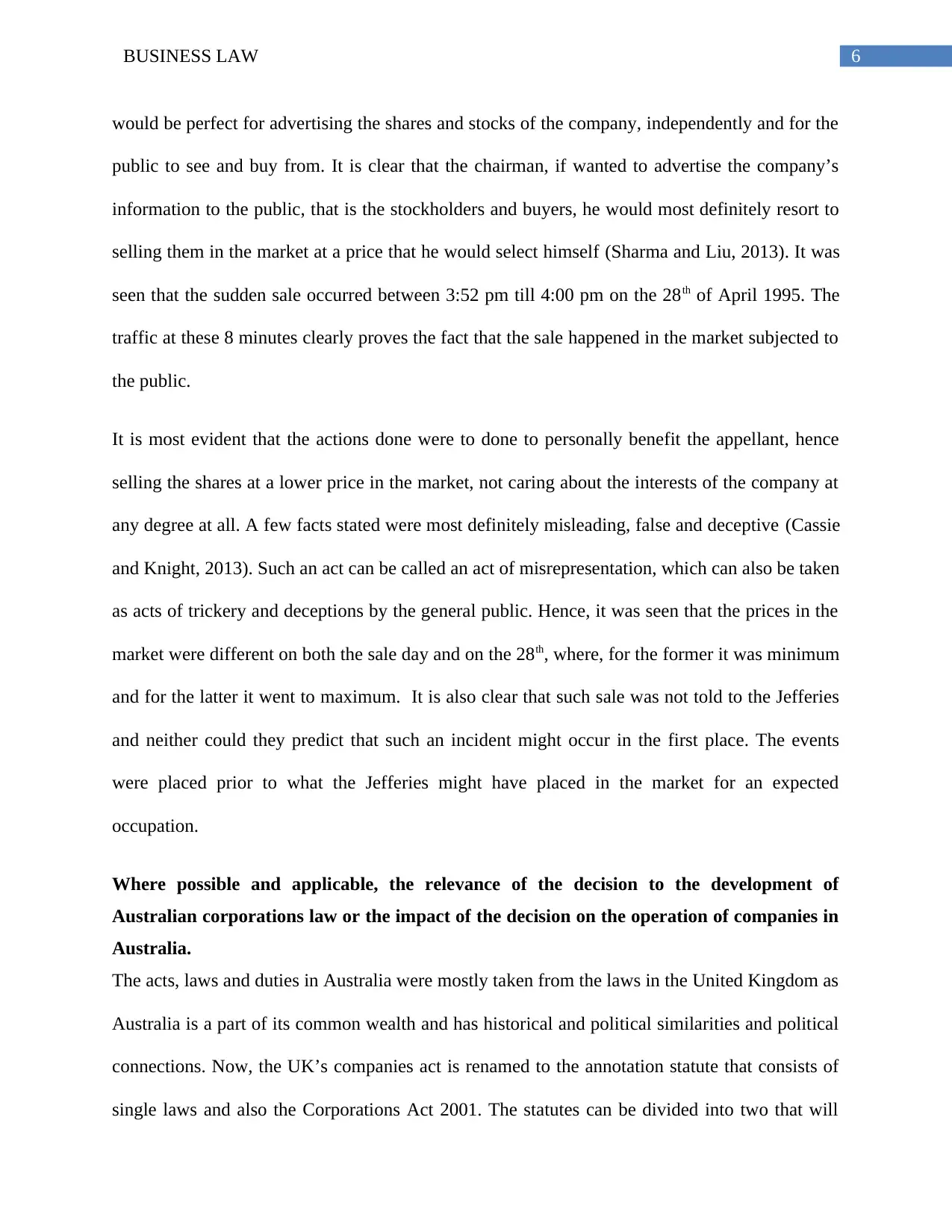
6BUSINESS LAW
would be perfect for advertising the shares and stocks of the company, independently and for the
public to see and buy from. It is clear that the chairman, if wanted to advertise the company’s
information to the public, that is the stockholders and buyers, he would most definitely resort to
selling them in the market at a price that he would select himself (Sharma and Liu, 2013). It was
seen that the sudden sale occurred between 3:52 pm till 4:00 pm on the 28th of April 1995. The
traffic at these 8 minutes clearly proves the fact that the sale happened in the market subjected to
the public.
It is most evident that the actions done were to done to personally benefit the appellant, hence
selling the shares at a lower price in the market, not caring about the interests of the company at
any degree at all. A few facts stated were most definitely misleading, false and deceptive (Cassie
and Knight, 2013). Such an act can be called an act of misrepresentation, which can also be taken
as acts of trickery and deceptions by the general public. Hence, it was seen that the prices in the
market were different on both the sale day and on the 28th, where, for the former it was minimum
and for the latter it went to maximum. It is also clear that such sale was not told to the Jefferies
and neither could they predict that such an incident might occur in the first place. The events
were placed prior to what the Jefferies might have placed in the market for an expected
occupation.
Where possible and applicable, the relevance of the decision to the development of
Australian corporations law or the impact of the decision on the operation of companies in
Australia.
The acts, laws and duties in Australia were mostly taken from the laws in the United Kingdom as
Australia is a part of its common wealth and has historical and political similarities and political
connections. Now, the UK’s companies act is renamed to the annotation statute that consists of
single laws and also the Corporations Act 2001. The statutes can be divided into two that will
would be perfect for advertising the shares and stocks of the company, independently and for the
public to see and buy from. It is clear that the chairman, if wanted to advertise the company’s
information to the public, that is the stockholders and buyers, he would most definitely resort to
selling them in the market at a price that he would select himself (Sharma and Liu, 2013). It was
seen that the sudden sale occurred between 3:52 pm till 4:00 pm on the 28th of April 1995. The
traffic at these 8 minutes clearly proves the fact that the sale happened in the market subjected to
the public.
It is most evident that the actions done were to done to personally benefit the appellant, hence
selling the shares at a lower price in the market, not caring about the interests of the company at
any degree at all. A few facts stated were most definitely misleading, false and deceptive (Cassie
and Knight, 2013). Such an act can be called an act of misrepresentation, which can also be taken
as acts of trickery and deceptions by the general public. Hence, it was seen that the prices in the
market were different on both the sale day and on the 28th, where, for the former it was minimum
and for the latter it went to maximum. It is also clear that such sale was not told to the Jefferies
and neither could they predict that such an incident might occur in the first place. The events
were placed prior to what the Jefferies might have placed in the market for an expected
occupation.
Where possible and applicable, the relevance of the decision to the development of
Australian corporations law or the impact of the decision on the operation of companies in
Australia.
The acts, laws and duties in Australia were mostly taken from the laws in the United Kingdom as
Australia is a part of its common wealth and has historical and political similarities and political
connections. Now, the UK’s companies act is renamed to the annotation statute that consists of
single laws and also the Corporations Act 2001. The statutes can be divided into two that will
Paraphrase This Document
Need a fresh take? Get an instant paraphrase of this document with our AI Paraphraser
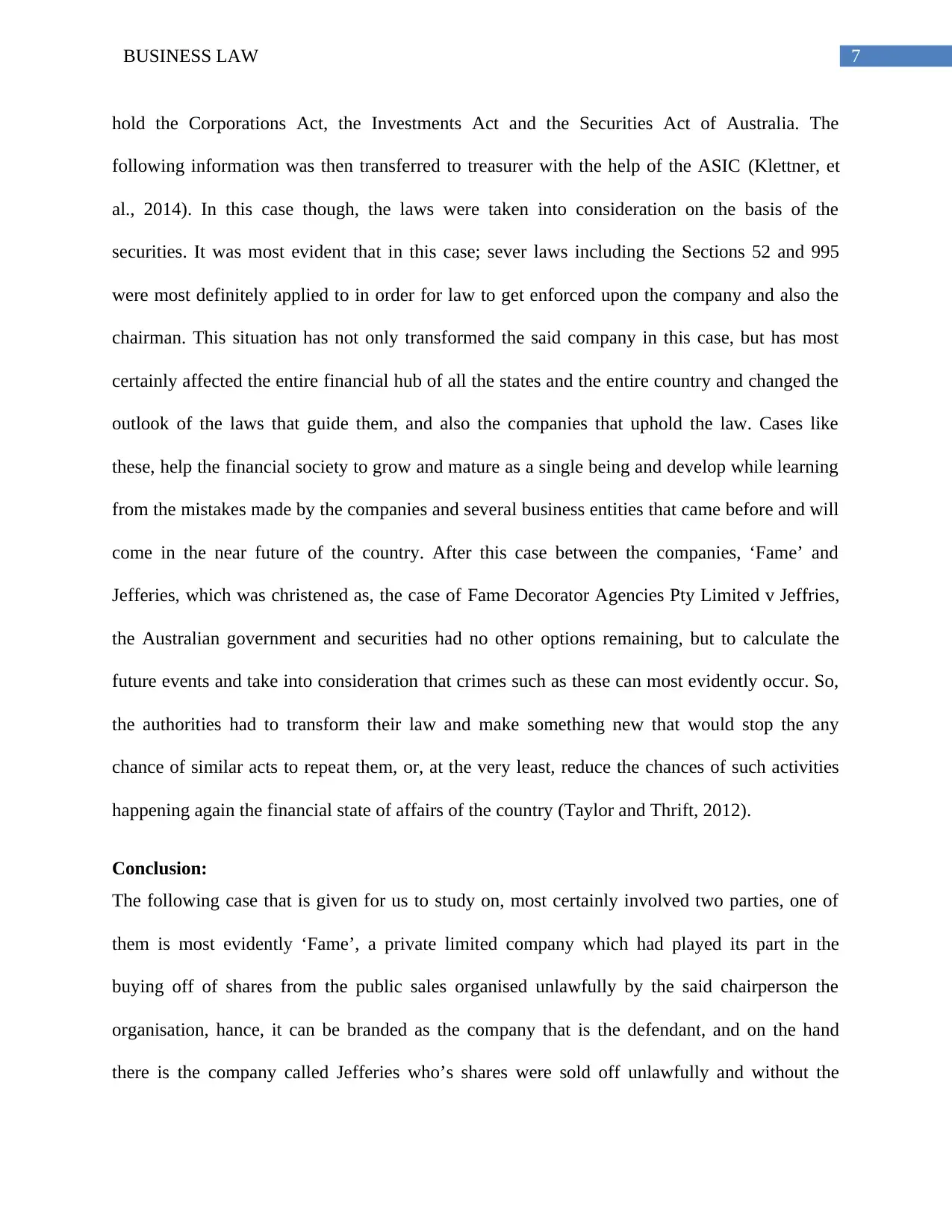
7BUSINESS LAW
hold the Corporations Act, the Investments Act and the Securities Act of Australia. The
following information was then transferred to treasurer with the help of the ASIC (Klettner, et
al., 2014). In this case though, the laws were taken into consideration on the basis of the
securities. It was most evident that in this case; sever laws including the Sections 52 and 995
were most definitely applied to in order for law to get enforced upon the company and also the
chairman. This situation has not only transformed the said company in this case, but has most
certainly affected the entire financial hub of all the states and the entire country and changed the
outlook of the laws that guide them, and also the companies that uphold the law. Cases like
these, help the financial society to grow and mature as a single being and develop while learning
from the mistakes made by the companies and several business entities that came before and will
come in the near future of the country. After this case between the companies, ‘Fame’ and
Jefferies, which was christened as, the case of Fame Decorator Agencies Pty Limited v Jeffries,
the Australian government and securities had no other options remaining, but to calculate the
future events and take into consideration that crimes such as these can most evidently occur. So,
the authorities had to transform their law and make something new that would stop the any
chance of similar acts to repeat them, or, at the very least, reduce the chances of such activities
happening again the financial state of affairs of the country (Taylor and Thrift, 2012).
Conclusion:
The following case that is given for us to study on, most certainly involved two parties, one of
them is most evidently ‘Fame’, a private limited company which had played its part in the
buying off of shares from the public sales organised unlawfully by the said chairperson the
organisation, hance, it can be branded as the company that is the defendant, and on the hand
there is the company called Jefferies who’s shares were sold off unlawfully and without the
hold the Corporations Act, the Investments Act and the Securities Act of Australia. The
following information was then transferred to treasurer with the help of the ASIC (Klettner, et
al., 2014). In this case though, the laws were taken into consideration on the basis of the
securities. It was most evident that in this case; sever laws including the Sections 52 and 995
were most definitely applied to in order for law to get enforced upon the company and also the
chairman. This situation has not only transformed the said company in this case, but has most
certainly affected the entire financial hub of all the states and the entire country and changed the
outlook of the laws that guide them, and also the companies that uphold the law. Cases like
these, help the financial society to grow and mature as a single being and develop while learning
from the mistakes made by the companies and several business entities that came before and will
come in the near future of the country. After this case between the companies, ‘Fame’ and
Jefferies, which was christened as, the case of Fame Decorator Agencies Pty Limited v Jeffries,
the Australian government and securities had no other options remaining, but to calculate the
future events and take into consideration that crimes such as these can most evidently occur. So,
the authorities had to transform their law and make something new that would stop the any
chance of similar acts to repeat them, or, at the very least, reduce the chances of such activities
happening again the financial state of affairs of the country (Taylor and Thrift, 2012).
Conclusion:
The following case that is given for us to study on, most certainly involved two parties, one of
them is most evidently ‘Fame’, a private limited company which had played its part in the
buying off of shares from the public sales organised unlawfully by the said chairperson the
organisation, hance, it can be branded as the company that is the defendant, and on the hand
there is the company called Jefferies who’s shares were sold off unlawfully and without the
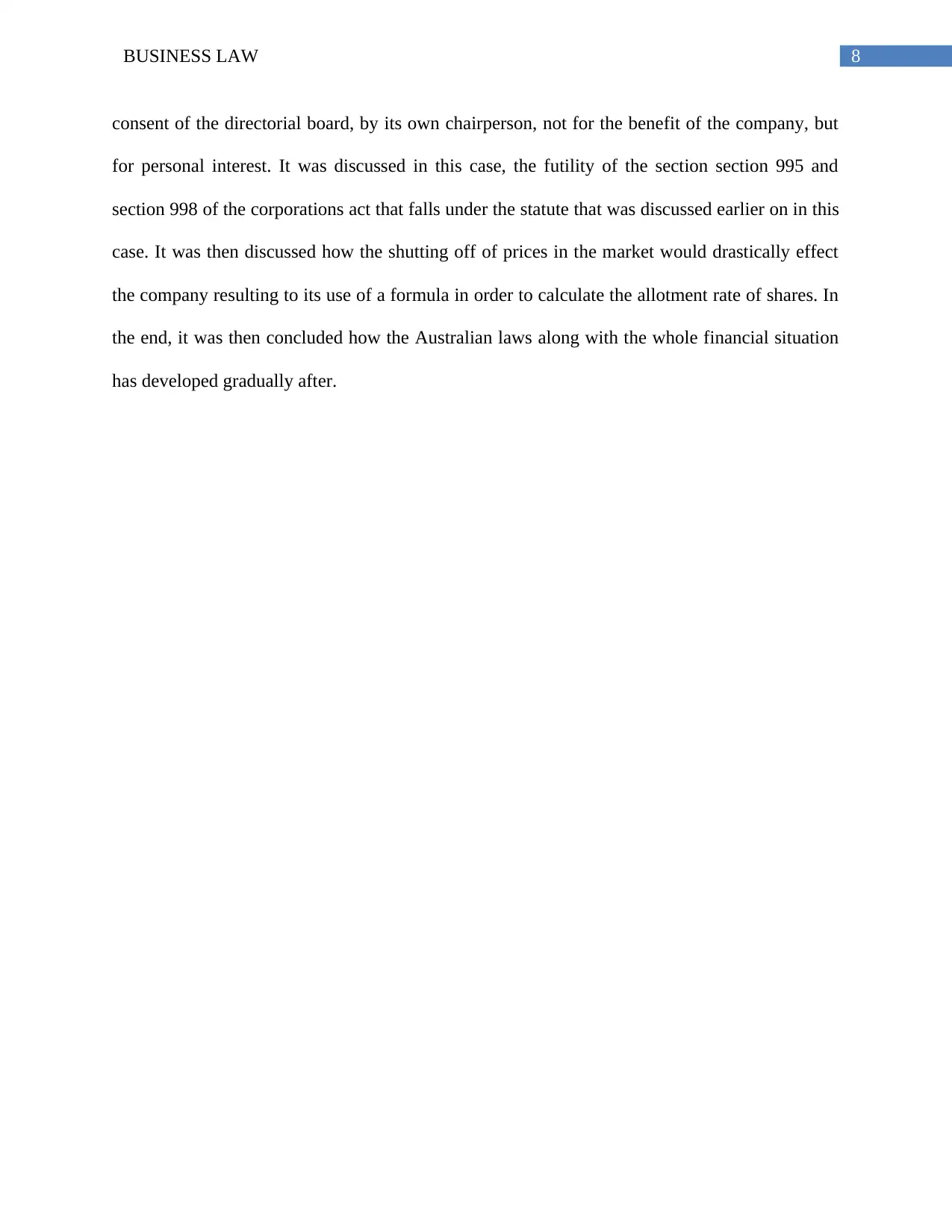
8BUSINESS LAW
consent of the directorial board, by its own chairperson, not for the benefit of the company, but
for personal interest. It was discussed in this case, the futility of the section section 995 and
section 998 of the corporations act that falls under the statute that was discussed earlier on in this
case. It was then discussed how the shutting off of prices in the market would drastically effect
the company resulting to its use of a formula in order to calculate the allotment rate of shares. In
the end, it was then concluded how the Australian laws along with the whole financial situation
has developed gradually after.
consent of the directorial board, by its own chairperson, not for the benefit of the company, but
for personal interest. It was discussed in this case, the futility of the section section 995 and
section 998 of the corporations act that falls under the statute that was discussed earlier on in this
case. It was then discussed how the shutting off of prices in the market would drastically effect
the company resulting to its use of a formula in order to calculate the allotment rate of shares. In
the end, it was then concluded how the Australian laws along with the whole financial situation
has developed gradually after.
⊘ This is a preview!⊘
Do you want full access?
Subscribe today to unlock all pages.

Trusted by 1+ million students worldwide
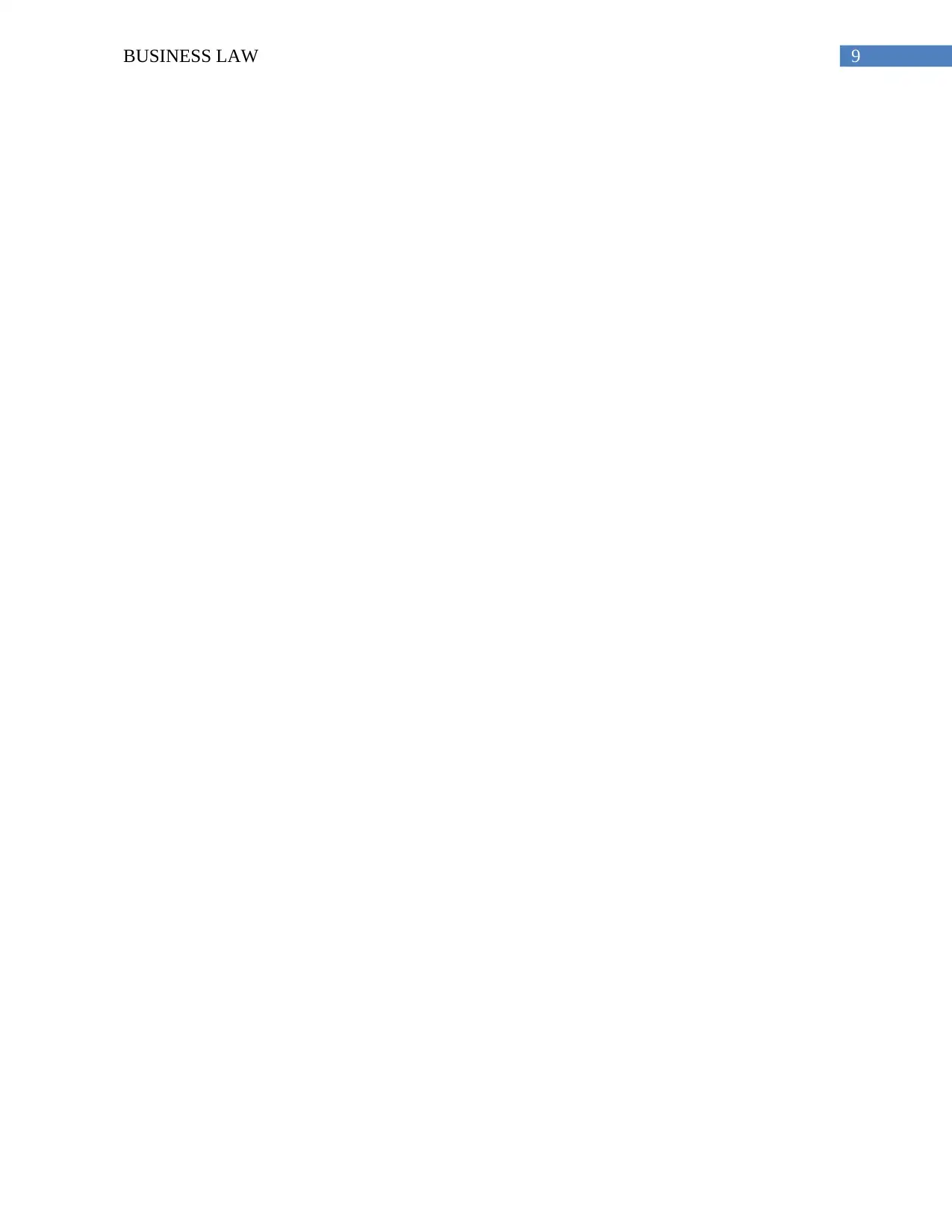
9BUSINESS LAW
Paraphrase This Document
Need a fresh take? Get an instant paraphrase of this document with our AI Paraphraser
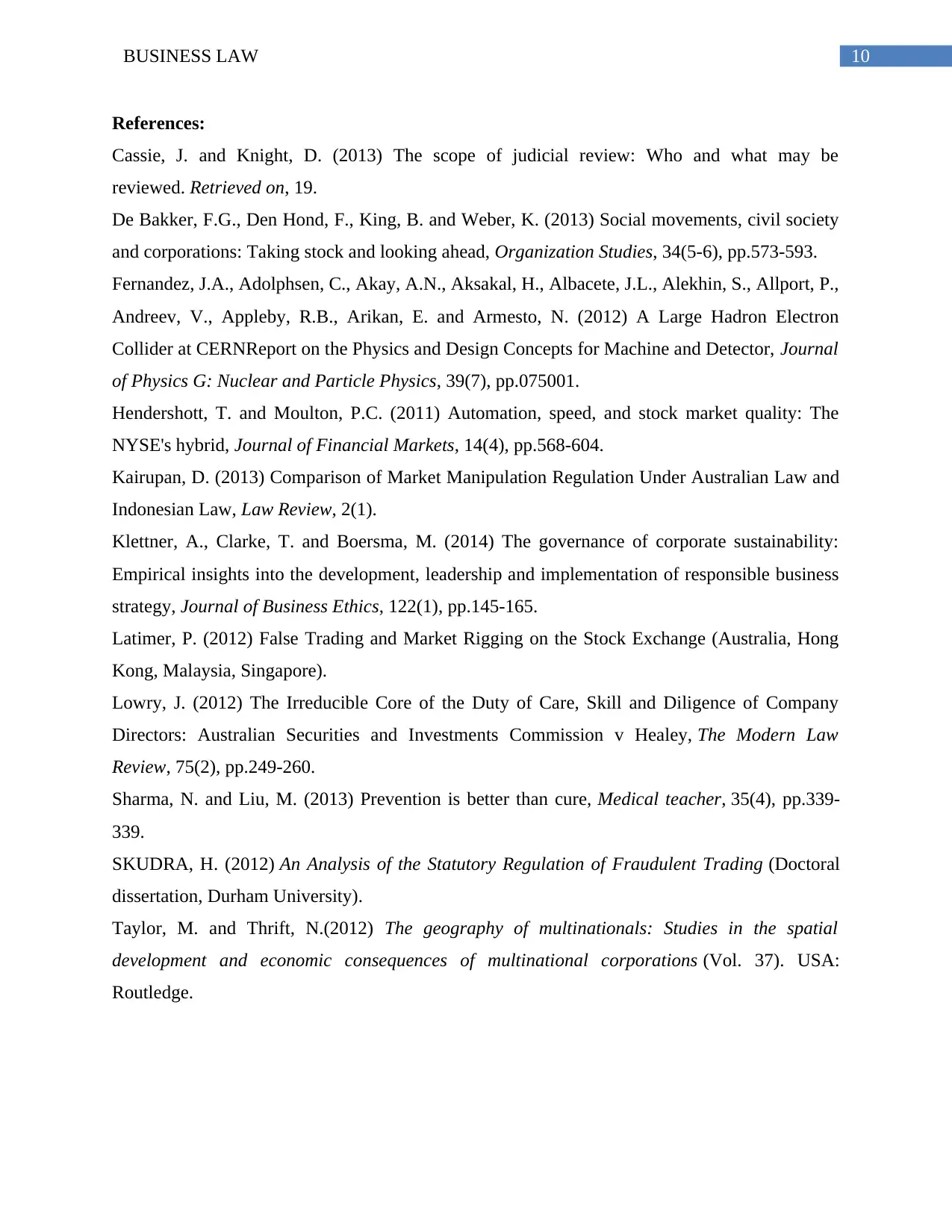
10BUSINESS LAW
References:
Cassie, J. and Knight, D. (2013) The scope of judicial review: Who and what may be
reviewed. Retrieved on, 19.
De Bakker, F.G., Den Hond, F., King, B. and Weber, K. (2013) Social movements, civil society
and corporations: Taking stock and looking ahead, Organization Studies, 34(5-6), pp.573-593.
Fernandez, J.A., Adolphsen, C., Akay, A.N., Aksakal, H., Albacete, J.L., Alekhin, S., Allport, P.,
Andreev, V., Appleby, R.B., Arikan, E. and Armesto, N. (2012) A Large Hadron Electron
Collider at CERNReport on the Physics and Design Concepts for Machine and Detector, Journal
of Physics G: Nuclear and Particle Physics, 39(7), pp.075001.
Hendershott, T. and Moulton, P.C. (2011) Automation, speed, and stock market quality: The
NYSE's hybrid, Journal of Financial Markets, 14(4), pp.568-604.
Kairupan, D. (2013) Comparison of Market Manipulation Regulation Under Australian Law and
Indonesian Law, Law Review, 2(1).
Klettner, A., Clarke, T. and Boersma, M. (2014) The governance of corporate sustainability:
Empirical insights into the development, leadership and implementation of responsible business
strategy, Journal of Business Ethics, 122(1), pp.145-165.
Latimer, P. (2012) False Trading and Market Rigging on the Stock Exchange (Australia, Hong
Kong, Malaysia, Singapore).
Lowry, J. (2012) The Irreducible Core of the Duty of Care, Skill and Diligence of Company
Directors: Australian Securities and Investments Commission v Healey, The Modern Law
Review, 75(2), pp.249-260.
Sharma, N. and Liu, M. (2013) Prevention is better than cure, Medical teacher, 35(4), pp.339-
339.
SKUDRA, H. (2012) An Analysis of the Statutory Regulation of Fraudulent Trading (Doctoral
dissertation, Durham University).
Taylor, M. and Thrift, N.(2012) The geography of multinationals: Studies in the spatial
development and economic consequences of multinational corporations (Vol. 37). USA:
Routledge.
References:
Cassie, J. and Knight, D. (2013) The scope of judicial review: Who and what may be
reviewed. Retrieved on, 19.
De Bakker, F.G., Den Hond, F., King, B. and Weber, K. (2013) Social movements, civil society
and corporations: Taking stock and looking ahead, Organization Studies, 34(5-6), pp.573-593.
Fernandez, J.A., Adolphsen, C., Akay, A.N., Aksakal, H., Albacete, J.L., Alekhin, S., Allport, P.,
Andreev, V., Appleby, R.B., Arikan, E. and Armesto, N. (2012) A Large Hadron Electron
Collider at CERNReport on the Physics and Design Concepts for Machine and Detector, Journal
of Physics G: Nuclear and Particle Physics, 39(7), pp.075001.
Hendershott, T. and Moulton, P.C. (2011) Automation, speed, and stock market quality: The
NYSE's hybrid, Journal of Financial Markets, 14(4), pp.568-604.
Kairupan, D. (2013) Comparison of Market Manipulation Regulation Under Australian Law and
Indonesian Law, Law Review, 2(1).
Klettner, A., Clarke, T. and Boersma, M. (2014) The governance of corporate sustainability:
Empirical insights into the development, leadership and implementation of responsible business
strategy, Journal of Business Ethics, 122(1), pp.145-165.
Latimer, P. (2012) False Trading and Market Rigging on the Stock Exchange (Australia, Hong
Kong, Malaysia, Singapore).
Lowry, J. (2012) The Irreducible Core of the Duty of Care, Skill and Diligence of Company
Directors: Australian Securities and Investments Commission v Healey, The Modern Law
Review, 75(2), pp.249-260.
Sharma, N. and Liu, M. (2013) Prevention is better than cure, Medical teacher, 35(4), pp.339-
339.
SKUDRA, H. (2012) An Analysis of the Statutory Regulation of Fraudulent Trading (Doctoral
dissertation, Durham University).
Taylor, M. and Thrift, N.(2012) The geography of multinationals: Studies in the spatial
development and economic consequences of multinational corporations (Vol. 37). USA:
Routledge.
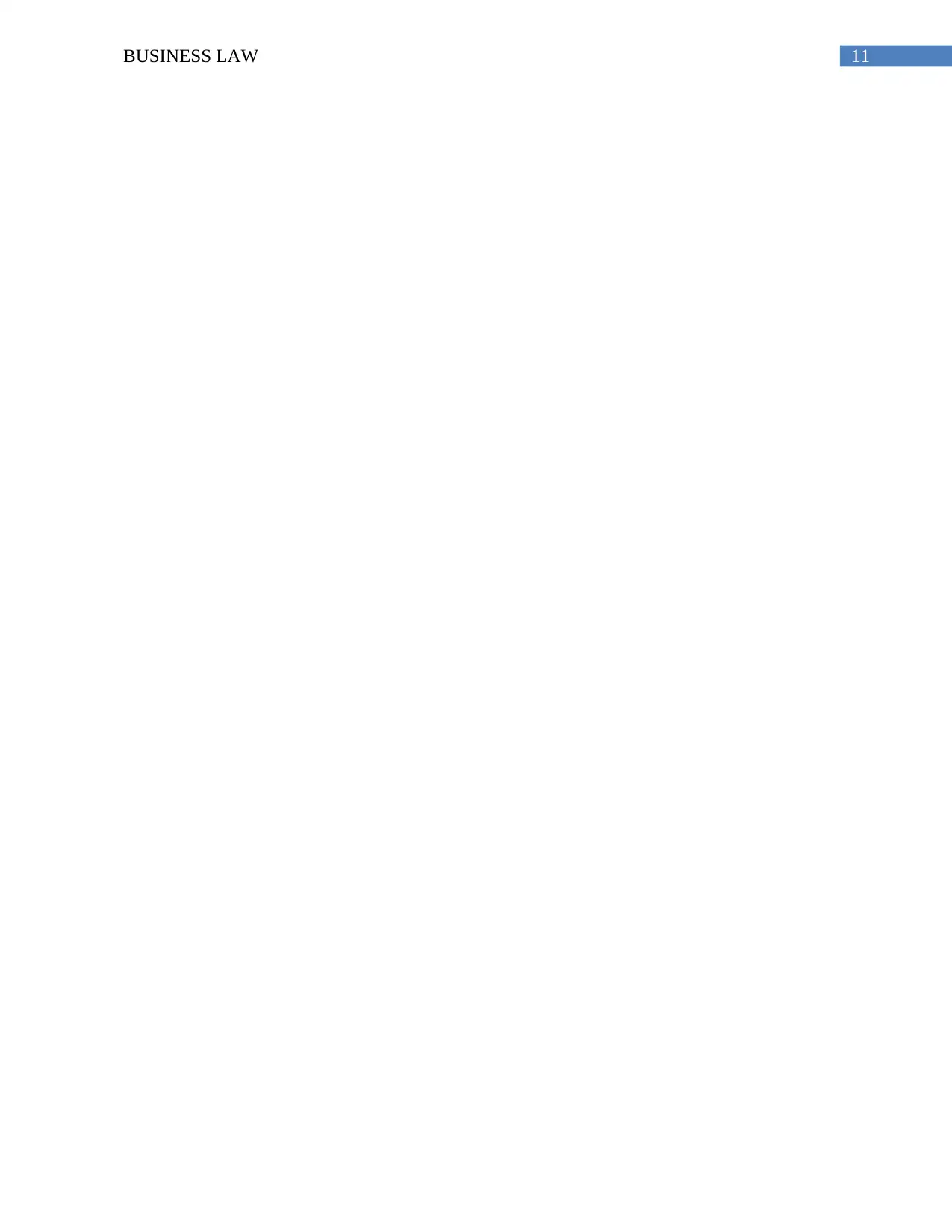
11BUSINESS LAW
⊘ This is a preview!⊘
Do you want full access?
Subscribe today to unlock all pages.

Trusted by 1+ million students worldwide
1 out of 12
Related Documents
Your All-in-One AI-Powered Toolkit for Academic Success.
+13062052269
info@desklib.com
Available 24*7 on WhatsApp / Email
![[object Object]](/_next/static/media/star-bottom.7253800d.svg)
Unlock your academic potential
Copyright © 2020–2025 A2Z Services. All Rights Reserved. Developed and managed by ZUCOL.





